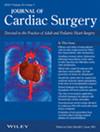用复活来扩展我们的想象力。
IF 1.3
4区 医学
Q3 CARDIAC & CARDIOVASCULAR SYSTEMS
引用次数: 0
摘要
本文章由计算机程序翻译,如有差异,请以英文原文为准。
Expanding our imagination with reanimation.
Orthotopic heart transplant remains the gold standard for the treatment of end‐stage heart failure. A major barrier to its utilization in all patients is a scarcity of candidates for organ donation. Historically, organs were only procured from donation after brain death (DBD), although its expansion in recent years has moved to donation after circulatory death (DCD). Following a variable “no touch” period after circulatory death, procurement teams race to salvage these higher‐risk organs for transplant. A significant concern with this donor pool is the warm ischemic time the organs face and their resultant increase in ischemia‐ reperfusion injury, leading to questionable graft function following transplant. Thoracoabdominal normothermic regional perfusion (TANRP) with extracorporeal membrane oxygenation (ECMO) devices has become a newer method of “reanimation” following circulatory death. The chest is opened, the head vessels clamped to ensure no possibility of circulation to the brain, and the patient is cannulated for venoarterial ECMO to restore perfusion to the thoracoabdominal organs. The arrested heart begins to beat again. This allows the heart team to inspect the beating heart and ensure it is appropriate for transplantation. The organ can then be procured and placed in cold storage if the team is satisfied. Early experiences in the United States and abroad have shown favorable outcomes for cardiac DCD compared to DBD, with cold ischemia times approaching 3 h. Ruiz et al. present a fascinating case of cardiac DCD utilizing TANRP and ECMO with a cold ischemia time of 201 min. In transplant, time is always of the essence and shorter ischemia times have been shown to lead to better outcomes. This comes under special consideration when warm ischemia is introduced into the picture, which can potentiate cardiac myocyte damage and function. Utilization of this technique for cardiac DCD not only helps to pick out favorable hearts, it also resets the ischemia clock allowing for cold storage from a favorable setpoint. Importantly, this technique expands the donor pool in a safe way without compromising graft quality. When addressing the organ shortage, it is imperative to not settle for suboptimal. This case demonstrates safety with 11min of functional warm ischemia time and over 3 h of cold ischemia with a favorable short‐ term outcome in their transplant recipient. The extent of allowable cold ischemia following cardiac DCD remains unknown, although this study reassures the beneficial effects of TANRP. This knowledge may help other surgeons push the time and distance boundary in DCD. However, more data utilizing this technique in cardiac DCD are required before we are able to make comprehensive recommendations on its use. We congratulate the authors on sharing their work and steadfast commitment to advancing the field of transplantation.
求助全文
通过发布文献求助,成功后即可免费获取论文全文。
去求助
来源期刊
CiteScore
2.90
自引率
12.50%
发文量
976
审稿时长
3-8 weeks
期刊介绍:
Journal of Cardiac Surgery (JCS) is a peer-reviewed journal devoted to contemporary surgical treatment of cardiac disease. Renown for its detailed "how to" methods, JCS''s well-illustrated, concise technical articles, critical reviews and commentaries are highly valued by dedicated readers worldwide.
With Editor-in-Chief Harold Lazar, MD and an internationally prominent editorial board, JCS continues its 20-year history as an important professional resource. Editorial coverage includes biologic support, mechanical cardiac assist and/or replacement and surgical techniques, and features current material on topics such as OPCAB surgery, stented and stentless valves, endovascular stent placement, atrial fibrillation, transplantation, percutaneous valve repair/replacement, left ventricular restoration surgery, immunobiology, and bridges to transplant and recovery.
In addition, special sections (Images in Cardiac Surgery, Cardiac Regeneration) and historical reviews stimulate reader interest. The journal also routinely publishes proceedings of important international symposia in a timely manner.

 求助内容:
求助内容: 应助结果提醒方式:
应助结果提醒方式:


